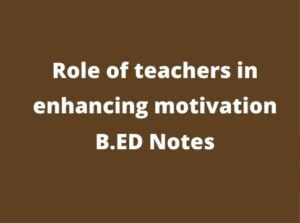E.L Thorndike (1874-1949) was the chief exponent of the theory of Trial and Error. According to Thorndike the basis of learning is accepted in an association between the sense, impressions and impulses to action.
This Association came to be known as a “bond” or a ‘Connection, Since it is these bonds or connections which become strengthened or weakened in the making and breaking of habits, Thorndike’s system is sometimes called a ‘bond’ psychology or simple ‘connectionism,
As it believes in stimulus and response type of learning it is also called S.R Psychology of learning. Thorndike called it learning by selecting and connecting. It is also known as Trial and Error theory as learning takes place through random repetitions
Experiment of Thorndike’s -Trial and Error Theory
Once he locked a hungry cat in a puzzle box and showed a slice of meat outside. The ultimate aim of the hungry cat was to obtain the meat. The cat could come outside only when it opens the door by removing the latch, but it was unaware as to how to remove the latch.
The cat did not know how to remove the latch at first but was involved in random activities like scratching the box, trying to bend the bars and stretching the feet outside. At last in its random activities, it lift up the latch and obtained the meat. He repeated the experiments and found that the cat released the latch itself easily. The realized association between lifting the latch and opening the door. The random activities are called errors.
Finally, he concludes that the number of trials will reduce the wrong responses and finally correct response is found. Hence, the bond is established between stimulus and correct response through the elimination of wrong response.
Laws of Learning: Trial and Error
Thorndike gives three laws of learning
- Law of Readiness
- Law of Effect
- Law of Exercise
Law of Readiness:
This law refers that learning taking place only when the learner is ready to learn. If a learner has to learn an action or activity he should be mentally and physically fit for the action he desired. His mental set should have the capacity to do the work. A two-year boy cannot be admitted to the school since he is not mature enough. A child of one year cannot speak since his vocal cords, the larynx is not grown enough. Hence, Child interest and maturity is essential
Law of Effect:
This law states that learning takes place properly when it results in satisfaction and the learner drives pleasure out of it. In the situation when the child meets failure or is dissatisfied, the progress on the path of learning is blocked. All the pleasant experiences have lasting influences and are remembered for a long time, while the unpleasant ones are soon forgotten. Therefore, the satisfaction or dissatisfaction, pleasure or displeasure obtained as a result of some learning ensure the degree of effectiveness of that learning.
This law emphasizes the role of rewards and punishment in the process of learning. Geeting rewards as a result of some learning motivate and encourage the child to proceed on the same path with more intensity and enthusiasm while the punishment of any sort discourages him and create distaste and repulsion towards that learning.
Laws of Exercise:
This law states that “Practice makes a man perfect”. The bond of strength and response will get strengthened if it is repeated. This law of exercise has been categorised into two parts-law of use and law of disuse
Law of use: When a modifiable connection is made between a situation and responses that connection’s strength and things being equal, increase.
Law of Disuse: When a modifiable connection is not made between a situation and response, during a length of time, that connection decreased.
Thus the law of use refers to the strengthening of connection with practice while the law of disuse refers to the weakening of connection or forgetting when the practice is discontinued.
Educational Implication of Thorndike’s-Trial and Error Theory
Thorndike’s Theory of trial and error and laws of learning have great educational significance. Thorndike’s findings have made the learning purposeful and goal-directed. Trial and error, coupled with insight will make the process of learning more effective, important educational implications are:
- This theory substantiated that readiness is preparation for action which is very essential for learning. If the child is ready to learn, he learns more quickly, effectively and with greater stratification than if he is not ready to learn. He warns us not to make the child learn till he is ready to learn and also not to miss any opportunity of providing learning experiences if the child is, already prepared to learn. The right movements concerning the learning situation and the learner’s state of mind should be very well recognized and maximum use of this knowledge should be made by the teacher. He should also make an attempt to motivate the students by arousing their attention, interest and curiosity.
- The law of effect emphasizes the role of rewards and punishment in the process of learning. Getting a reward as a result of some learning motivates and encourages the child to proceed on the same path with more intensity and enthusiasm while the punishment of any sort discourages him and creates distaste and distraction towards that learning.
- In the teaching-learning process, the teacher tries to strengthen the bonds and connections between the stimuli and the responses those things which are to be remembered by the learners. This could be done through drill, repetition and reward. For forgetting he should make attempts to weaken the connections through disuse and annoying elements.
- Repetitions in learning strengthen the connections in achieving the goal which could be achieved by rewarding the correct responses.
- The child should be encouraged to do his work independently by the strengthening effect of rewards rather than the weakening effect of punishment.
Conclusion
We can conclude from the above points, Thorndike’s theory and laws of learning have contributed a lot to educational theory and practice. It has made learning purposeful and goal-directed and has brought motivation to the forefront. It has also given impetus to the work of practice, drill and repetition and realized the psychological importance of rewards and praise in the process of teaching and learning.
References:
- S.K, Mangal. (2007). Essentials of Education Psychology. Prentice-Hall India Learning Private Limited.
- Dharmaraj, D. (2021). Retrieved 22 November 2021, from https://www.bdu.ac.in/cde/docs/ebooks/B-Ed/I/LEARNING%20AND%20TEACHING.pdf



